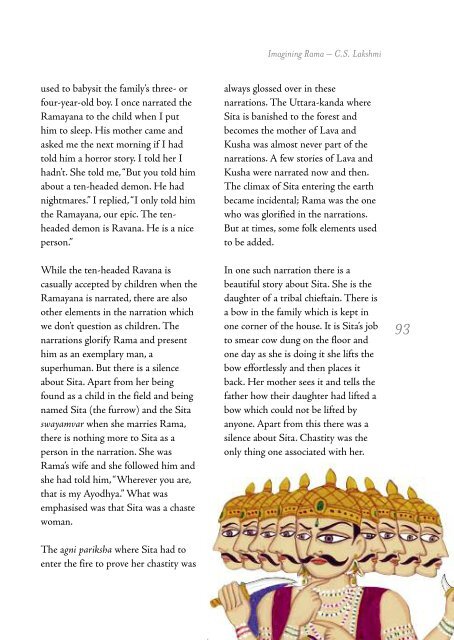Layout 3 - India Foundation for the Arts - IFA
Layout 3 - India Foundation for the Arts - IFA
Layout 3 - India Foundation for the Arts - IFA
You also want an ePaper? Increase the reach of your titles
YUMPU automatically turns print PDFs into web optimized ePapers that Google loves.
used to babysit <strong>the</strong> family’s three- or<br />
four-year-old boy. I once narrated <strong>the</strong><br />
Ramayana to <strong>the</strong> child when I put<br />
him to sleep. His mo<strong>the</strong>r came and<br />
asked me <strong>the</strong> next morning if I had<br />
told him a horror story. I told her I<br />
hadn’t. She told me, “But you told him<br />
about a ten-headed demon. He had<br />
nightmares.” I replied, “I only told him<br />
<strong>the</strong> Ramayana, our epic. The tenheaded<br />
demon is Ravana. He is a nice<br />
person.”<br />
While <strong>the</strong> ten-headed Ravana is<br />
casually accepted by children when <strong>the</strong><br />
Ramayana is narrated, <strong>the</strong>re are also<br />
o<strong>the</strong>r elements in <strong>the</strong> narration which<br />
we don’t question as children. The<br />
narrations glorify Rama and present<br />
him as an exemplary man, a<br />
superhuman. But <strong>the</strong>re is a silence<br />
about Sita. Apart from her being<br />
found as a child in <strong>the</strong> field and being<br />
named Sita (<strong>the</strong> furrow) and <strong>the</strong> Sita<br />
swayamvar when she marries Rama,<br />
<strong>the</strong>re is nothing more to Sita as a<br />
person in <strong>the</strong> narration. She was<br />
Rama’s wife and she followed him and<br />
she had told him, “Wherever you are,<br />
that is my Ayodhya.” What was<br />
emphasised was that Sita was a chaste<br />
woman.<br />
The agni pariksha where Sita had to<br />
enter <strong>the</strong> fire to prove her chastity was<br />
Imagining Rama – C.S. Lakshmi<br />
always glossed over in <strong>the</strong>se<br />
narrations. The Uttara-kanda where<br />
Sita is banished to <strong>the</strong> <strong>for</strong>est and<br />
becomes <strong>the</strong> mo<strong>the</strong>r of Lava and<br />
Kusha was almost never part of <strong>the</strong><br />
narrations. A few stories of Lava and<br />
Kusha were narrated now and <strong>the</strong>n.<br />
The climax of Sita entering <strong>the</strong> earth<br />
became incidental; Rama was <strong>the</strong> one<br />
who was glorified in <strong>the</strong> narrations.<br />
But at times, some folk elements used<br />
to be added.<br />
In one such narration <strong>the</strong>re is a<br />
beautiful story about Sita. She is <strong>the</strong><br />
daughter of a tribal chieftain. There is<br />
a bow in <strong>the</strong> family which is kept in<br />
one corner of <strong>the</strong> house. It is Sita’s job<br />
to smear cow dung on <strong>the</strong> floor and<br />
one day as she is doing it she lifts <strong>the</strong><br />
bow ef<strong>for</strong>tlessly and <strong>the</strong>n places it<br />
back. Her mo<strong>the</strong>r sees it and tells <strong>the</strong><br />
fa<strong>the</strong>r how <strong>the</strong>ir daughter had lifted a<br />
bow which could not be lifted by<br />
anyone. Apart from this <strong>the</strong>re was a<br />
silence about Sita. Chastity was <strong>the</strong><br />
only thing one associated with her.<br />
93


